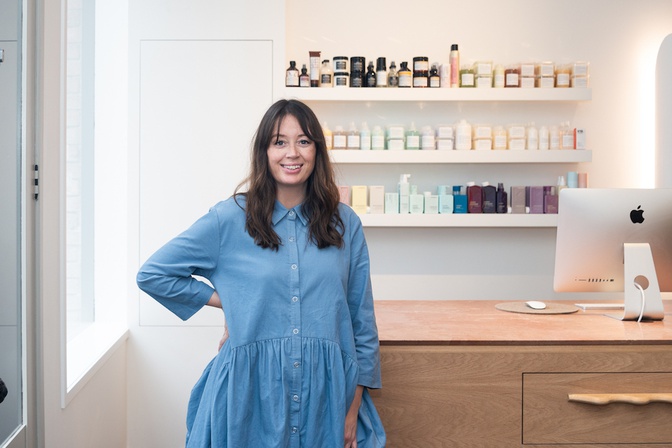From cutting hair in friends’ bathrooms to building a thriving salon – in partnership with WorkSafe Victoria, Donna Sheridan talks about creating a safe and healthy work environment and the lessons she’s learned along the way.

Down a Fitzroy backstreet, on the ground floor of a wedding-dress shop, you’ll find the Donna Sheridan hairdressing salon.
Sheridan has built a thriving business by doing things differently. The pace here is slower and calmer than your typical salon. There isn’t any pressure to make small talk. There’s a focus on sustainability – in all aspects of the business, including people and mental health.
After training in New Zealand and working overseas, Sheridan migrated to Melbourne, where she worked in a chain salon for seven years. Her feelings about that time are mixed. While she loved the team and the people she worked with, conditions were tough.
“It's really, really hard for apprentices because they get paid absolutely nothing,” says Sheridan. “They don't get treated well, they don't get respected and they never get a lunch break. Everyone just got bullied, in a way to be honest.” Starting her own salon was a way to shift this dynamic, creating an atmosphere where everyone got a say. Sheridan first tested the waters by finding a space to cut hair on her days off.
“I found this real dodgy warehouse in Collingwood,” says Sheridan. “It was so dire.” But with a friend’s encouragement, Sheridan decided she was all in and went into business for herself. She took out a $3000 loan and renovated the space to bring it up to standard. She was terrified and stressed about the money. But things went better than she had hoped. After a year, she realised she needed a bigger space and moved into a room in the salon’s current Fitzroy location.
Though she now had a client base and more space to work with, she says the move from Collingwood to Fitzroy “really made me lose the plot”. The rent was much higher, there was the cost of a new fit-out, and even though finances were stable, her anxiety skyrocketed. “I think [it was] just the fear of fully [running a business] on my own that time,” she says.
Sheridan sought help from a therapist. “[That] gave me was a safe space to explore my feelings and emotions,” she explains. Talking things through with a professional helped her identify ways to make the workplace more relaxed – not just for clients, but for herself and her employees. “It also helped put in place my own personal boundaries and needs, which in return contributed to a safer, more pleasant work environment.”
“A client will overshare to a hairdresser, and then a hairdresser will overshare back to make the client feel comfortable,” Sheridan says. “And then, all of a sudden, you’re speaking about extremely personal things. So I focus on the environment – how things look, how the temperature is, what music is playing – to make it comfortable to not [have to] speak. Then the client is relaxed and feels like they don’t need to [overshare]. It means the atmosphere is lighter for everyone.”
Sheridan explains how oversharing can be draining – and how for many staff the exhaustion from oversharing has the potential to tip the scale away from work being the creative pursuit it should be.
“With much younger hairdressers, they share so much because they’re told by their bosses over and over again to check in, to keep engaged and keep talking.” While her salon doesn’t have any apprentices, she makes sure her employees know there is no pressure to talk and they can focus on the creative process instead. It’s the sort of model that makes for a good workplace: leaders instigating regular staff check-ins, being accessible and approachable when a topic is too heavy-handed, or making sure staff have the opportunity to de-brief. Strong induction processes also help.
Sheridan has been learning in other ways as she goes. In her first solo location, she would work late on her own and often felt unsafe. Now, she has security cameras and protocols in place – like prioritising hairdressers not working alone, but when it’s unavoidable, locking the door.
She’s also conscious of warning off burnout. “We keep an eye on how many hours each stylist works,” she says. “It's a physically demanding job. And I believe you are more creative and can give more attention to care when you are not jaded and running on a long, heavy schedule.” The business also holds team meetings once a month with a different team member running things each time. Sheridan also meets with individual staff members every few months. “It's just awareness,” she adds. “Seeing that someone is down and asking them, you know, ‘Are you okay?”
Finally, when asked about the challenges of starting your own business, Sheridan says it just comes down to knowing you can do it.
“There are so many steps to get somewhere,” she says. “You’ve just got to start.”
This story is produced by Broadsheet in partnership with WorkSafe Victoria. WorkSafe Victoria has resources to support employers building safe and mentally healthy workplaces, and provides advice for employees on their rights. For step-by-step advice for preventing mental injury check out WorkSafe’s WorkWell Toolkit.
Photography: Samantha Schultz



